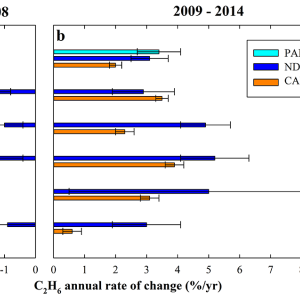The resolution from the International Association of Meteorology and Atmospheric Sciences (IAMAS) was released on November 22, 2017. This resolution specifically stresses the importance of continuation and enhancement of Earth Observation systems to monitor the atmosphere, ocean and other elements of the Earth system.
News and Events
The proposal from the Australian Bureau of Meteorology for NDACC affiliation for four Dobson measurements was discussed and approved at the 2017 NDACC Steering Committee Meeting in Boulder, Colorado. The measurements were formally invited as NDACC Affiliated shortly thereafter.
The annual meeting of the international Steering Committee (SC) for NDACC was held 6–10 November 2017 in Boulder, CO, USA at the National Center for Atmospheric Research (NCAR).
2016 marks 25 years of successful operations of NDACC for enabling and enhancing global atmospheric research. A comprehensive review article commemorating this anniversary appears in the September–October 2016 issue of NASA’s Earth Observer Newsletter.
The annual meeting of the international Steering Committee (SC) for NDACC was held from October 17 to 21 in Bremen, Germany at the University of Bremen Guesthouse 'Teerhof'. Justus Notholt of the University of Bremen hosted the meeting.
A global network of stations using Dobson and Brewer spectrophotometer have been monitoring the status of the ozone layer during several decades. Corresponding calibration systems have been developed to ensure the good and constant data quality in this network.
AMT published recommendations for the use of standardized vertical resolution and uncertainty for the NDACC ozone and temperature lidars in three special Issues on NDACC's 25th anniversary.
The seventh SPARC science report on 'The Mystery of Carbon Tetrachloride' is now available! The full report helps to answer policy-relevant questions related to the global budget of carbon tetrachloride, an important ozone-depleting substance, closing the gap between emission reported to UNEP's Ozone Secretariat and those estimated from atmospheric observations.
The 8th Implementation and Coordination Meeting (ICM-8) of the GCOS Reference Upper-Air Network (GRUAN) was held in Boulder, CO (25–29 April 2016). GRUAN and NDACC have had a long-standing collaboration (dating back to ICM-1 in 2009) that was further formalized by both GRUAN and NDACC becoming Cooperating Networks.
Until recently, the abundance of atmospheric ethane (C2H6) has been declining, primarily due to reduced fugitive emissions from oil and gas activities and to the successful implementation of pollution abatement measures.
